Sweet & Aromatic Pinecone Jam Recipe (Tastes Like Pine Cone Honey)
This post may contain affiliate links. Read my full disclosure here.
It all started with researching pinecones, and whether or not they were edible. Sure, you can make pine needle tea, and eat bark, but cones? Enter pinecone jam – the latest addition to my home apothecary.
I’ll share how to make pine cone jam, plus safety and storage tips. We’ll talk a little about the medicinal qualities of evergreens, and other easy homemade tonics.
Note – most of the photos in the article feature spruce cones, which is what we have available on our land. I’ll explain a bit more about which conifer species are safe to use in this recipe, and which are not.
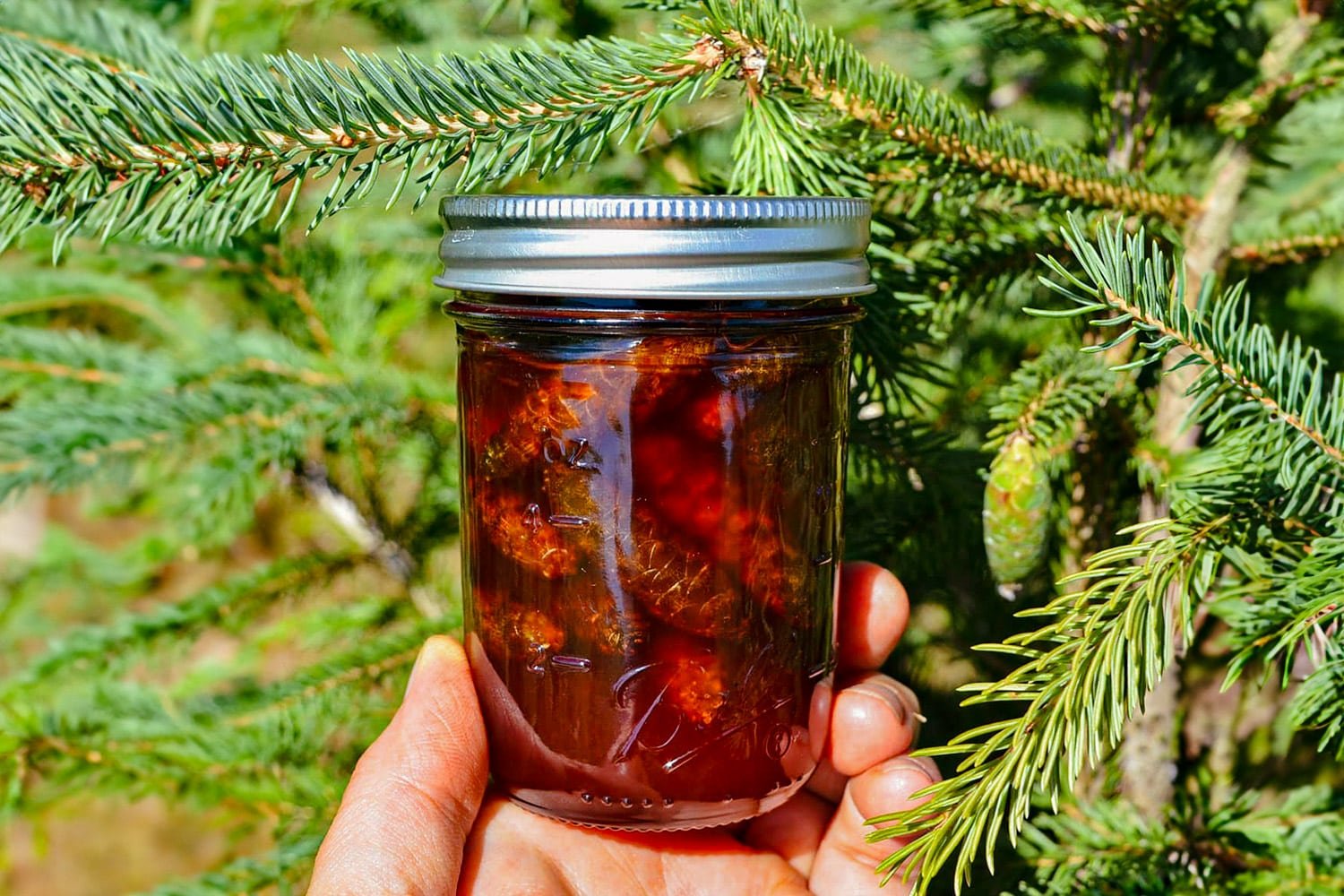
Table of contents
What is Pinecone Jam?
Pinecone jam isn’t really a jam at all, but a thick sugar syrup with well-cooked baby pine cones. It’s more like pine cone honey, with floral notes and a slightly resinous finish.
You can use this recipe with other edible conifers, to make spruce cone jam or fir cone jam. Those names don’t quite roll off the tongue like pinecone jam, so I used “pinecone” for the title.
The best cones to use are covered in sticky resin, so you may want to wear gloves while working with the cones. To remove resin from kitchen utensils, using rubbing alcohol (isopropyl alcohol).
Edible Conifers that are Safe for Jam (and Trees to Avoid)
You can make jam/honey with most types of evergreen, but there are some that it’s best to avoid.
Evergreen (Conifers) that are Safe to Use for Jam and Needle Tea include:
- Pine – such as white pine or pitch pine
- Fir – such as Fraser fir, Douglas fir, or balsam fir
- Spruce – such as blue spruce, Norway spruce, or white spruce
Evergreen trees to avoid using in your jam: yew, cypress, and cedar. These may be used medicinally at times, but they’re not what we’re looking for in this recipe.
Nowadays people are allergic to almost everything, so always try a small sample before eating a larger amount. The flavor of pinecone jam is fairly strong. I don’t think most people would be inclined to eat an entire jar in one sitting.
When you’re selecting cones, makes sure to pick those that are small, green, and resinous. Old, dry cones are best left for craft projects. Remove stems and try to keep the cones clean.
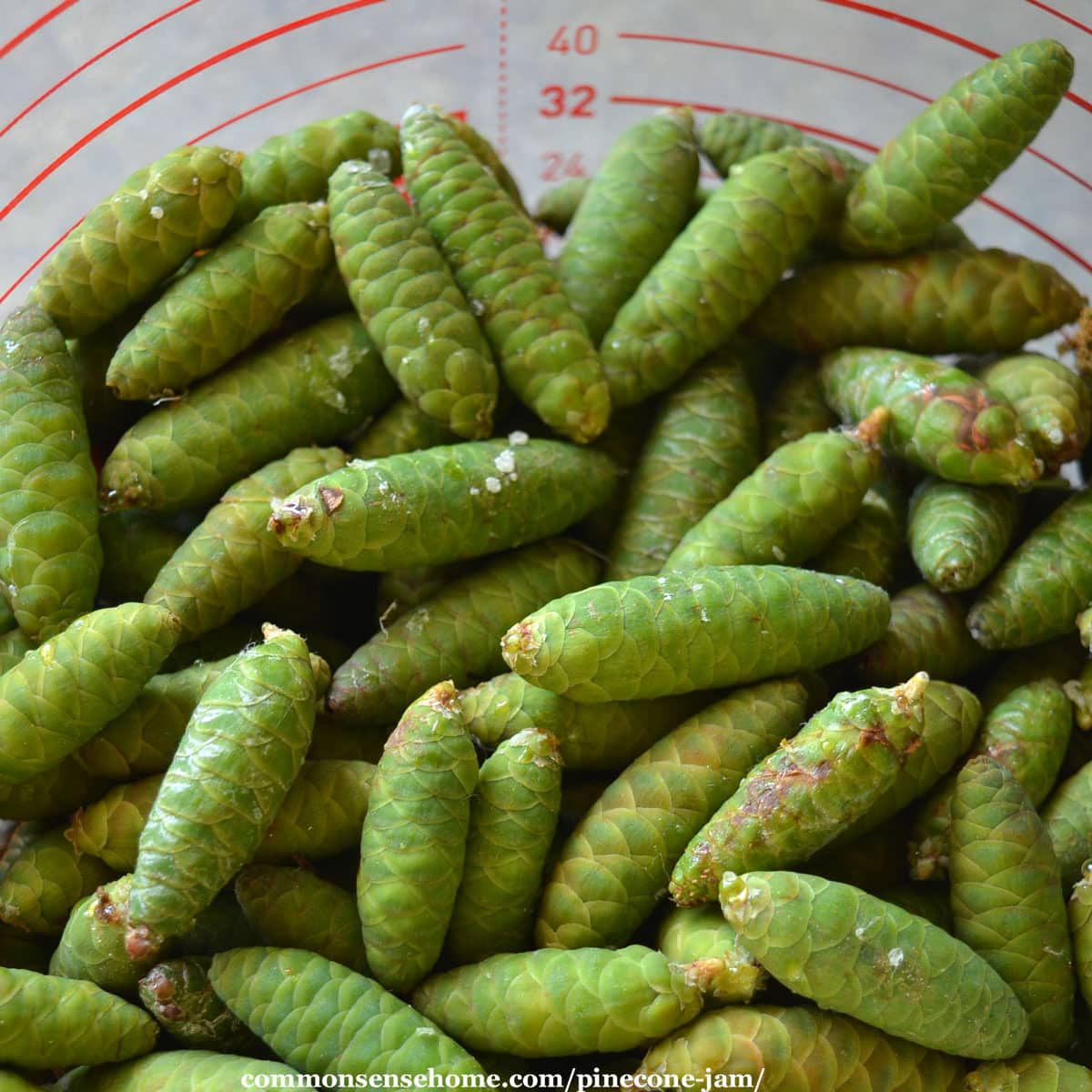
How to Make Pinecone Jam
All you need to make the “jam” is young pine cones, water, and sugar. Start digging around on the internet, and you’ll find all sorts of variations. People use different types of sugar, apple cider, spices, etc., but I like to let the trees take center stage.
I’ve been enjoying the heady scent from our evergreen trees this summer, and the jam captures that in a jar.
Ingredients
I used:
- About 2 pounds small green cones (~5 cups)
- 3 pounds organic cane sugar
- 4 cups water
Directions
Making the jam is simple, but requires several rounds of cooking and cooling, so plan ahead. It’s best to start early in the day when you have other tasks nearby. I ended up doing half the cooking one evening and finishing the next morning.
Rinse any debris off your cones, and then put them in a large pot with the sugar and water. Put the pot on the stove, stir until the sugar is dissolved, and bring to a boil. Cook at a moderate boil for 15-20 minutes, stirring occasionally. Remove from heat and allow to cool.
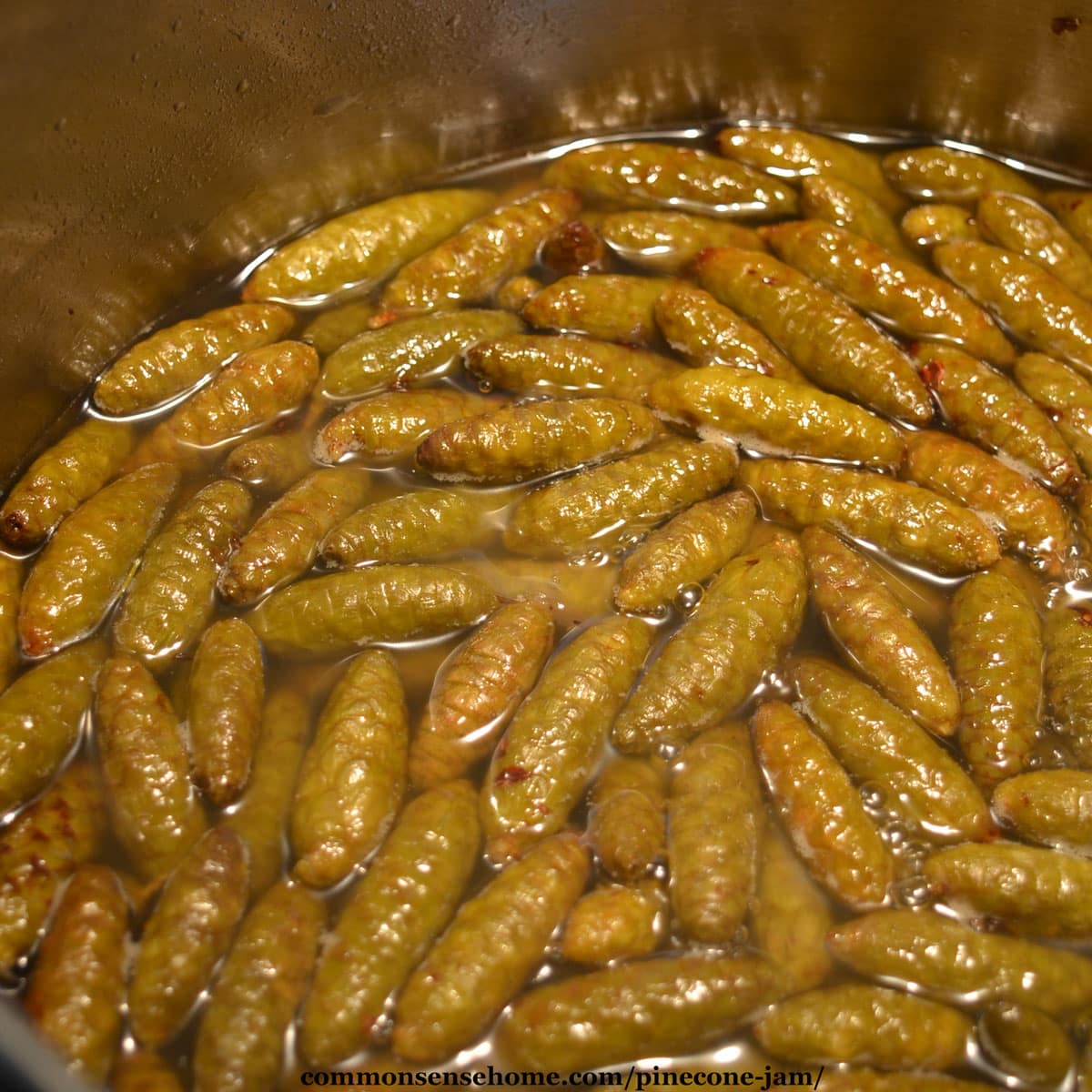
At this point, the liquid with be somewhat grey in color, and the cones will darken. Let the mixture cool completely before starting the next round of cooking.
Once the mixture is cool, put it back on the heat and bring to a boil again. Boil for 30 minutes, stirring occasionally. As it cooks, the mixture thickens, and the liquid changes color from grey to red-brown. The pinecones turn brown.
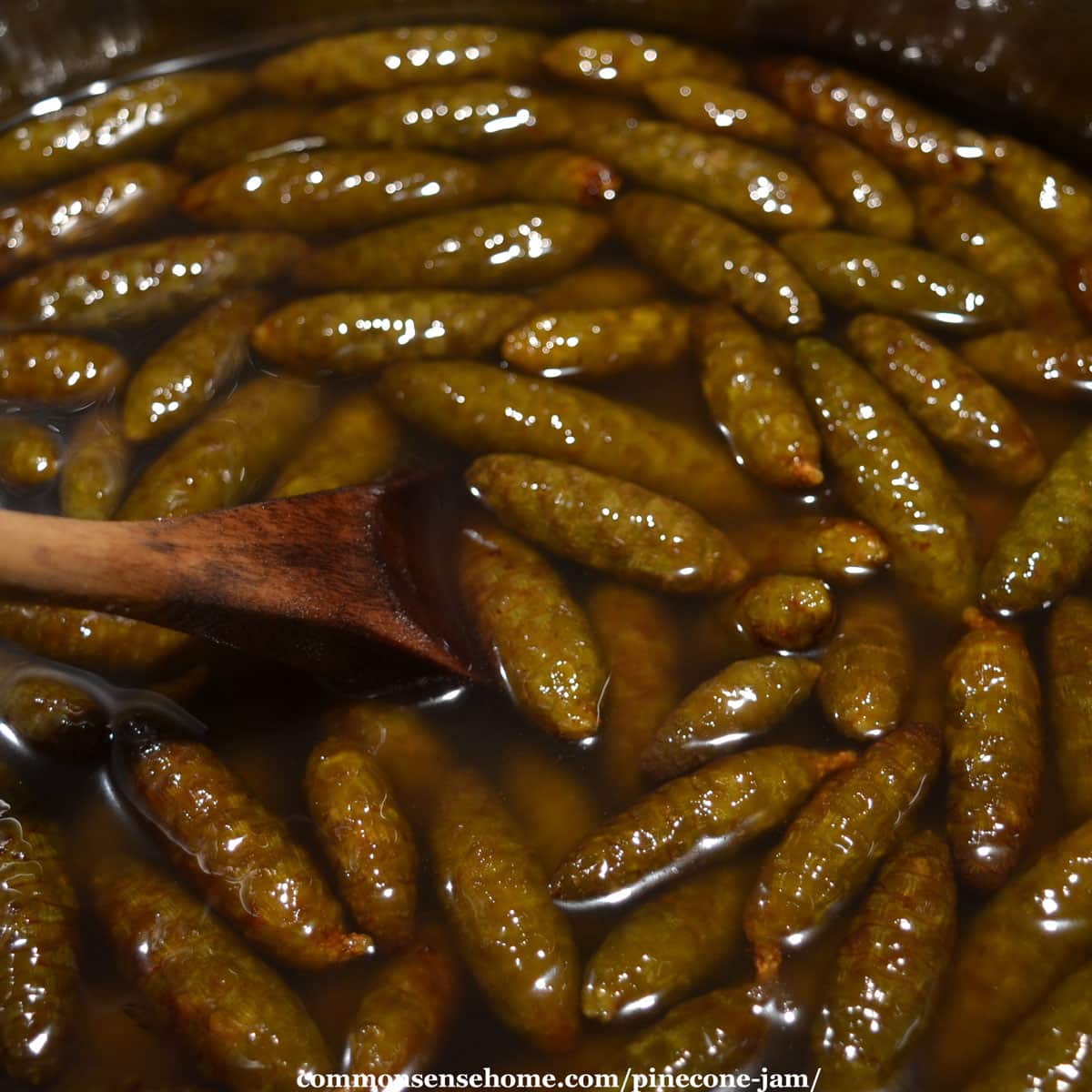
After a half hour, remove the pot from the heat and let it cool again. Once cooled, return it to the stove top one more time. Boil for around 30 minutes, until the syrup is as thick as you like. Remember, once it cools, the syrup will thicken, so it’s helpful to do a gelling test.
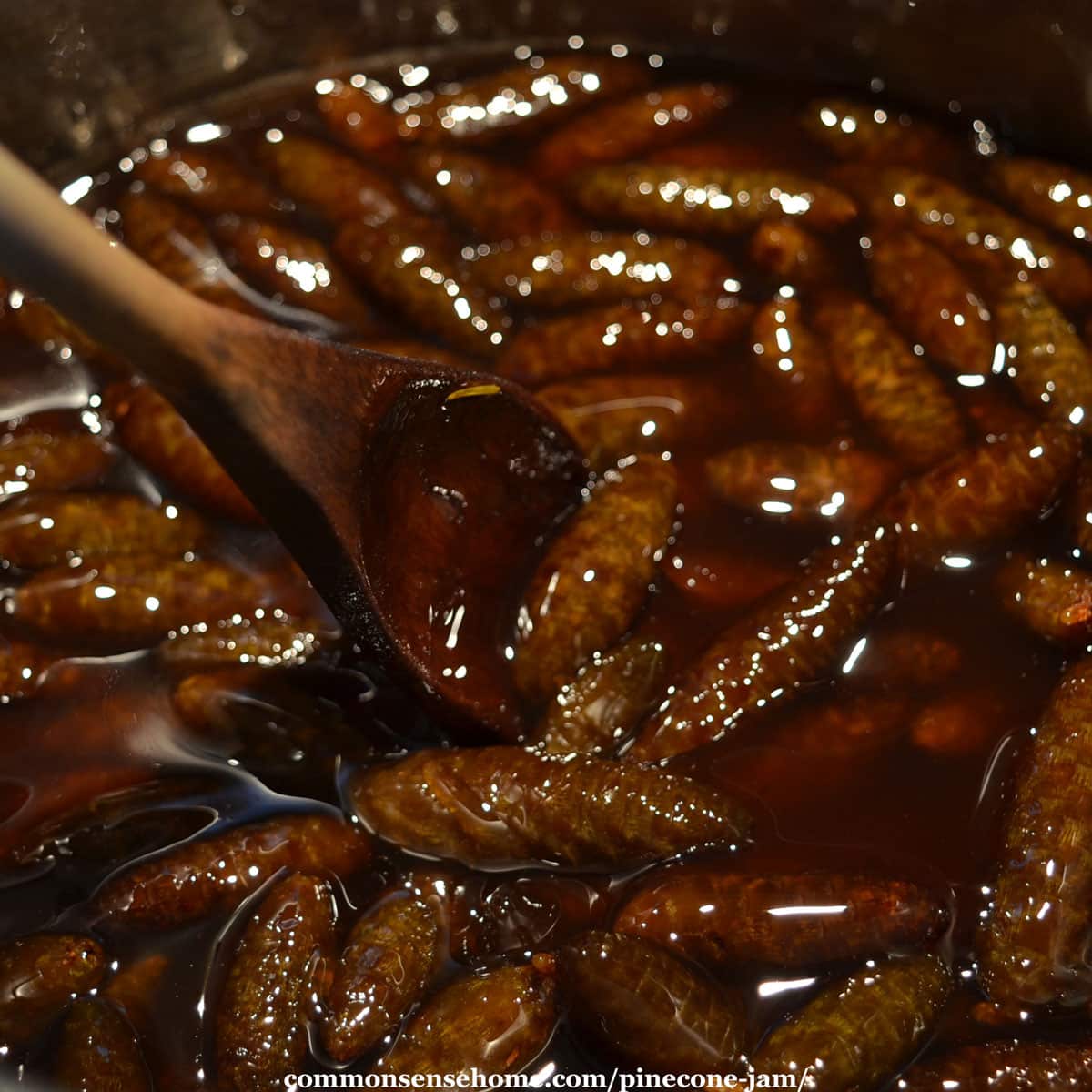
Simple Gelling Test
While the jam is cooking, place a plate in the refrigerator to chill. When you think your jam is done, remove the plate from the refrigerator. Drip some of the syrup onto the plate.
Would you like to save this?
If the syrup is cooked enough, it will gel into neat drops. If it spreads wide on the plate, cook it a little more.
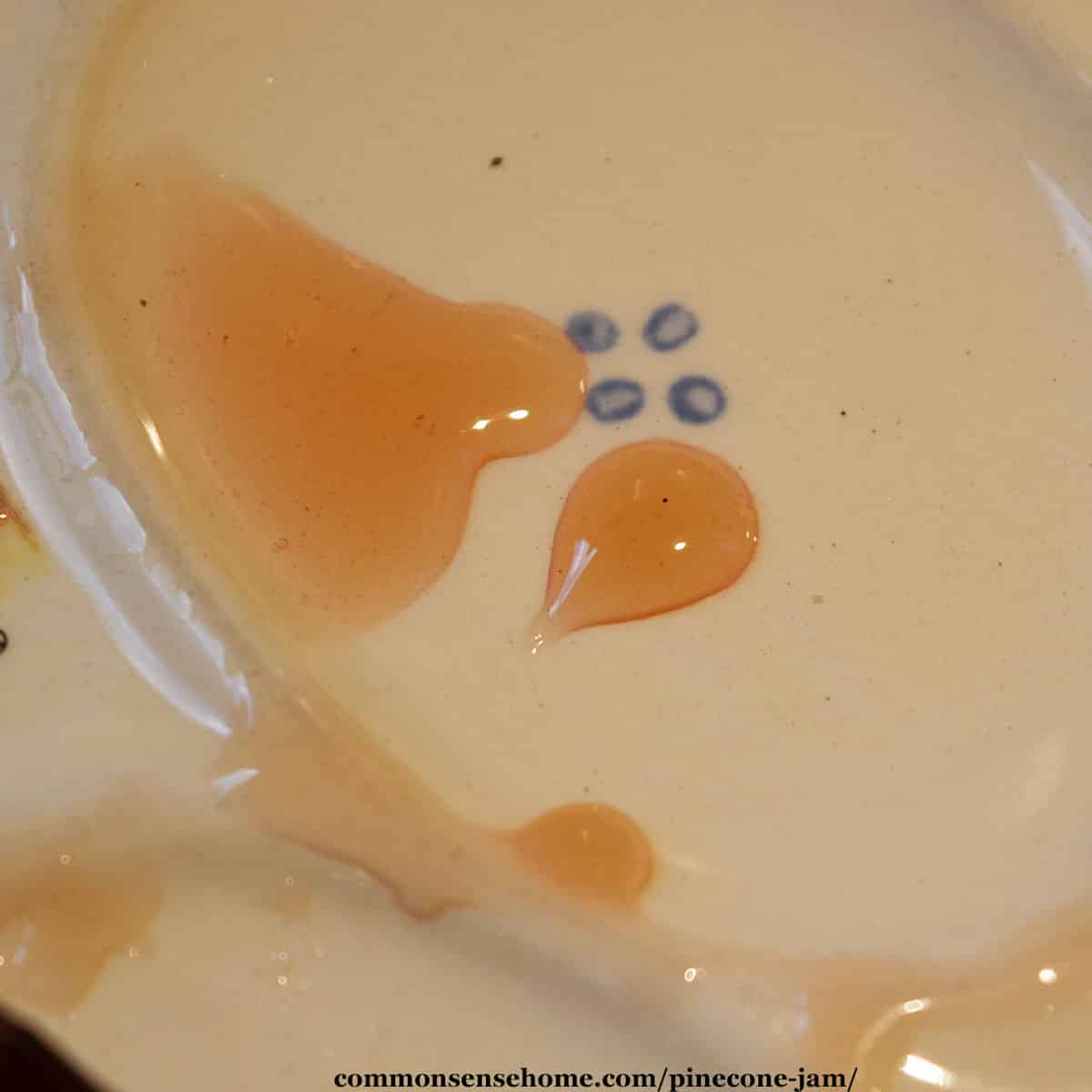
Is It Safe for Canning?
I did a pH test of my finished pinecone jam, and the pH was 4.5. The pine cones naturally acidify the mix. If you recall, we need a pH at or below 4.6 for safe water bath canning.
If you don’t have a way to check pH, the safest option is to store your jam in the refrigerator. With the high sugar content, it should keep for several months.
For water bath canning, I used one fourth inch headspace, and processed for 10 minutes.
It’s best to use this product sooner rather than later, because the sugar crystallizes with extended storage. Make it when the young cones are available, and use it that same year.
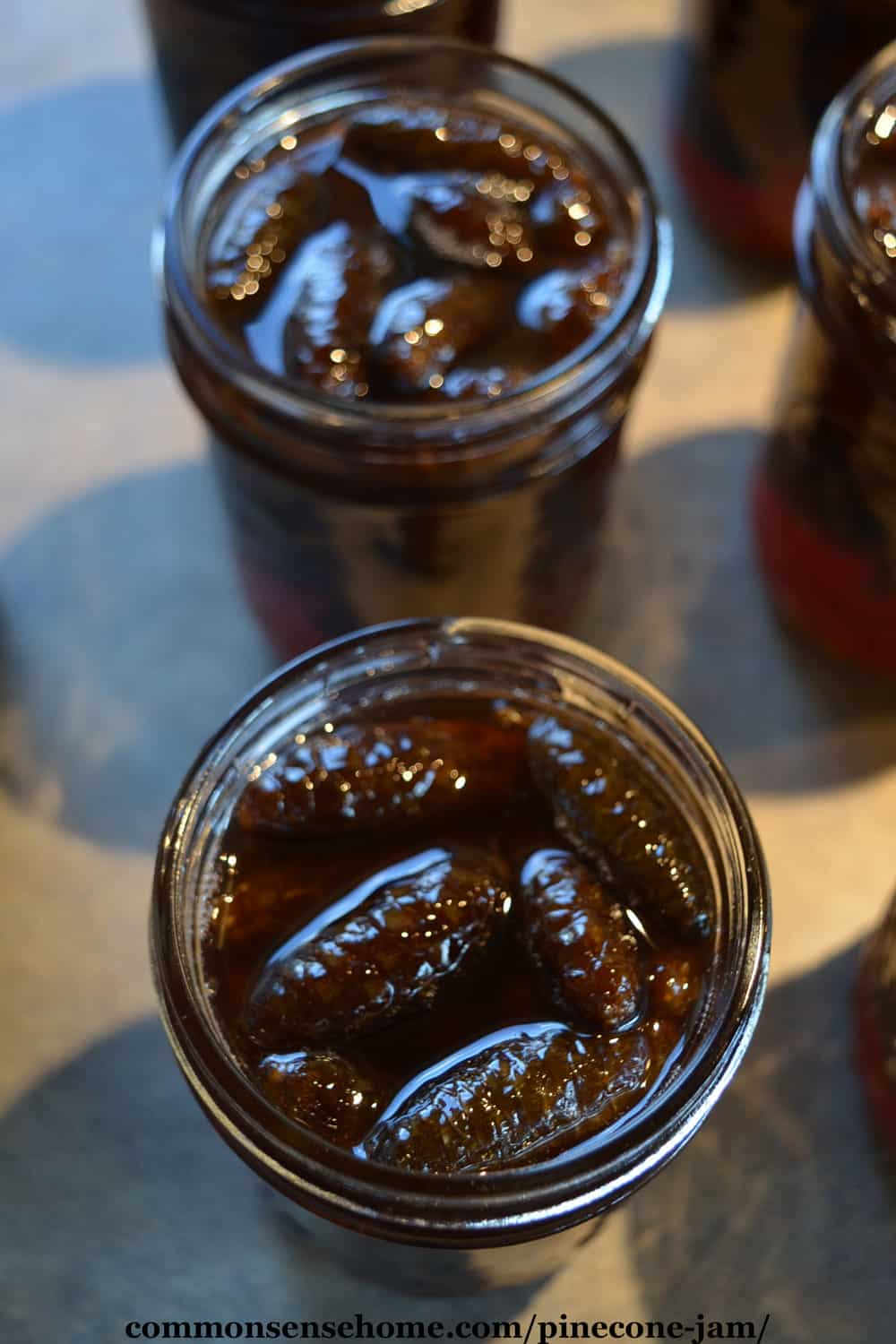
How Does Baby Pinecone Jam Taste?
The finished pinecone jam is like an herbal honey, with a slightly resinous finish. The exact flavor varies with the species used, cooking time, and growing conditions for the cones.
Can You Eat the Pinecones in Pinecone Jam?
Yes, the pinecones are edible. Although, adult pinecones and some young pinecones may be too tough to eat, depending on the weather conditions. Very young pinecones typically soften after cooking for long periods, and can be eaten.
We’ve been in near drought conditions for the last couple of months, and our cones were tough, even with extended cooking. Even after storage, these green cones did not soften.
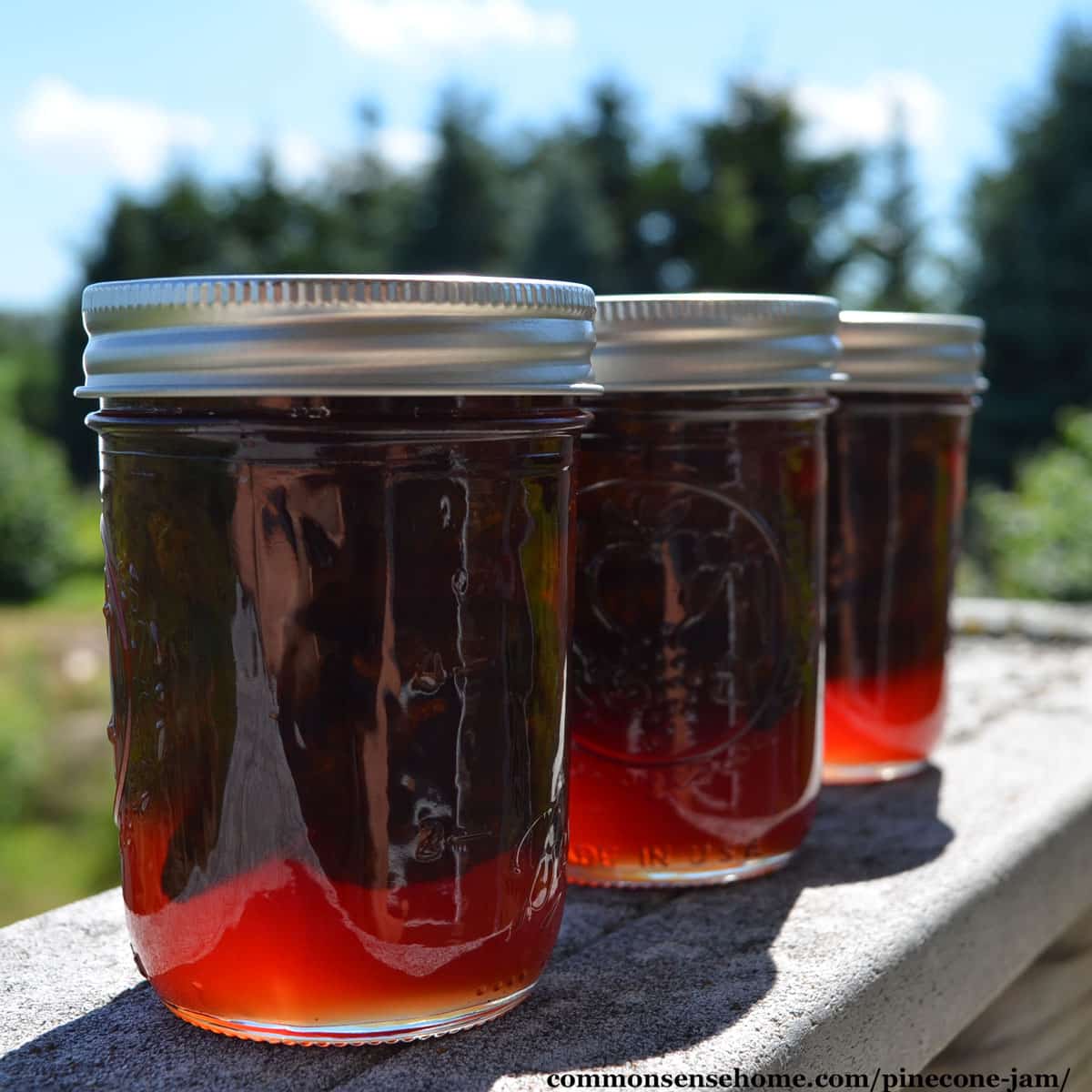
Medicinal Use of Pinecone Jam and Conifers
In the eastern European regions this jam hails from, it’s treated as a health tonic, not just a condiment. Similar to elderberry syrup, a spoonful or two a day helps to boost the immune system.
Recent research takes a closer look at the phytochemicals in conifers, noting high levels of alkaloids, terpenes and polyphenols.
The article “Conifers Phytochemicals: A Valuable Forest with Therapeutic Potential” highlights some of the potential benefits.
- Terpenes – antiviral, anti-inflammatory, neuroprotective, anticancer, antioxidant
- Alkaloids – antitumor, anti-hyperglycemic, antibacterial
- Polyphenols – antioxidants, antidiabetic, antimicrobial, neuroprotective
Another study looking at the antioxidant properties of conifer cones found the small green cones had the highest antioxidant values.
If you have access to healthy conifer trees, it’s definitely worth using them for herbal remedies.
PrintSweet & Aromatic Pinecone Jam
This richly scented jam smells like Christmas on your stove top. It’s good paired with mellow, creamy cheese, or taken by the spoonful as a winter tonic.
- Yield: 7 cups 1x
Ingredients
- About 2 pounds small green cones (~5 cups)
- 3 pounds organic cane sugar
- 4 cups water
Instructions
Making the jam is simple, but requires several rounds of cooking and cooling, so plan ahead. It’s best to start early in the day when you have other tasks nearby. I ended up doing half the cooking one evening and finishing the next morning.
Rinse any debris off your cones, and then put them in a large pot with the sugar and water. Put the pot on the stove, stir until the sugar is dissolved, and bring to a boil. Cook at a moderate boil for 15-20 minutes, stirring occasionally. Remove from heat and allow to cool.
At this point, the liquid with be somewhat grey in color, and the cones will start to darken. Let the mixture cool completely before starting the next round of cooking.
Once the mixture is cool, put it back on the heat and bring to a boil again. Boil for 30 minutes, stirring occasionally. As it cooks, the mixture thickens, and the liquid changes color from grey to red-brown. The pinecones turn brown.
After a half hour, remove the pot from the heat and let it cool again. Once cooled, return it to the stove top one more time. Boil for around 30 minutes, until the syrup is as thick as you like. Remember, once it cools, the syrup will thicken, so it’s helpful to do a gelling test.
Simple Gelling Test
While the jam is cooking, place a plate in the refrigerator to chill. When you think your jam is done, remove the plate from the refrigerator. Drip some of the syrup onto the plate.
If the syrup is cooked enough, it will gel into neat drops. If it spreads wide on the plate, cook it a little more.
Notes
I did a pH test of my finished pinecone jam, and the pH was 4.5. The pine cones naturally acidify the mix. If you recall, we need a pH at or below 4.6 for safe water bath canning.
If you don’t have a way to check pH, the safest option is to store your jam in the refrigerator. With the high sugar content, it should keep for several months.
For water bath canning, I used one fourth inch headspace, and processed for 10 minutes.
Use rubbing alcohol to remove the sticky pinecone resin from your cooking utensils and hands. You might want to wear gloves to work with the cones.
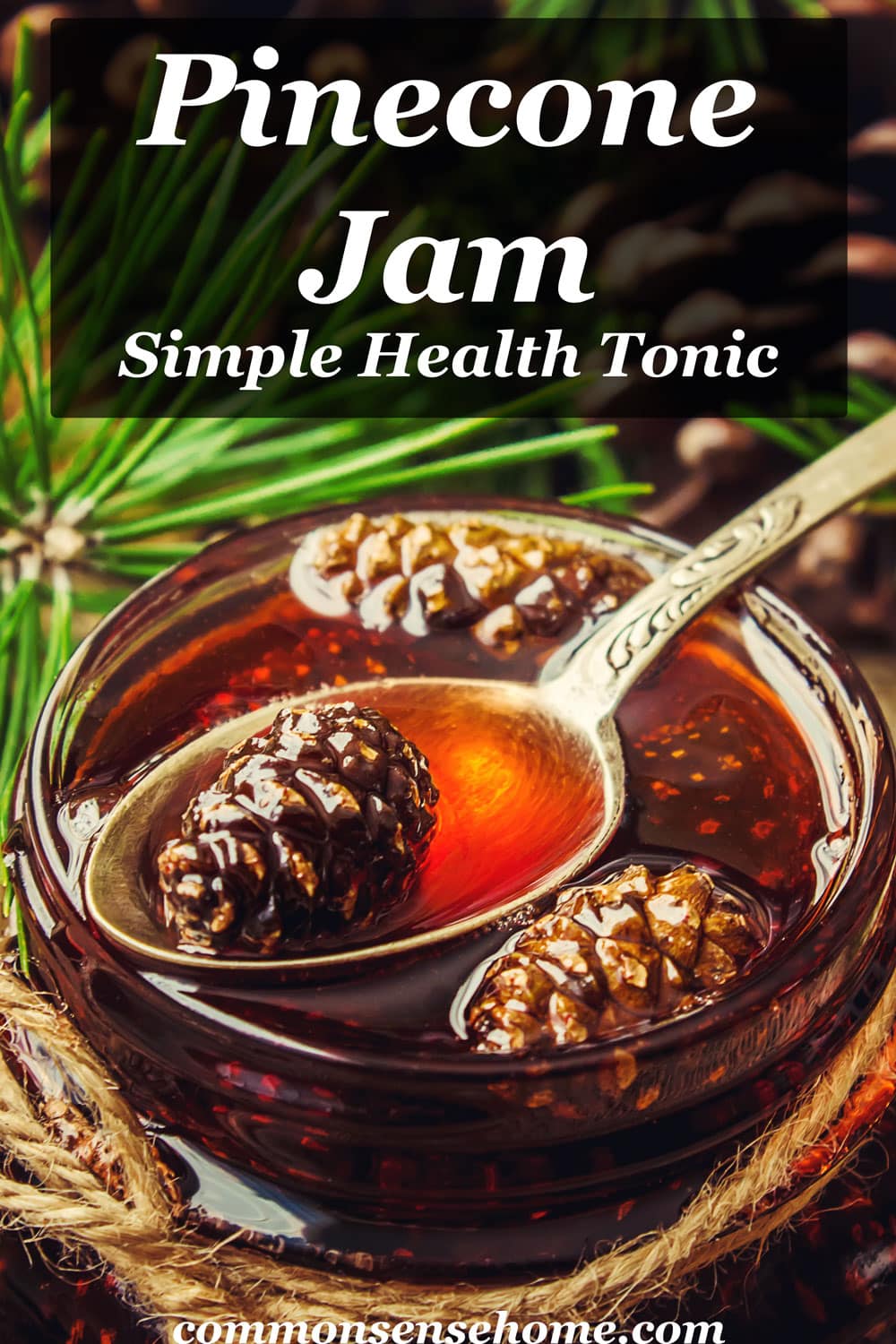
More Preserves and Home Remedies
If you’d like to experiment with more than pinecone jam, try:
We have dozens of different jams, jellies, and preserves on the site, along with an assortment of home remedies. You may also enjoy:
Honey as Medicine – honey is amazing for wound care
Thieves Vinegar – Immune Booster and Germ Killer

This article is written by Laurie Neverman. Laurie is a lifelong learner with a passion for natural remedies and holistic healing. She’s successfully improved her eyesight, cleared her psoriasis, and gotten off of prescription medication.
Last updated June 2024.



To avoid misinterpretation – do you also eat the pinecones or just the liquid part of the jam?
If the pine cones are small enough when picked, they may be edible, but the ones in the photo had too much roughage for my taste.
Wow! Wondering if you think adding lemon juice would be okay?
If you want to try adding lemon juice, I’d do it earlier in the process while it’s still watery, so it cooks down along with everything else.
My grandma use to do this in Romania , in the spring time we were gathering the fir tree tips from the branches. They have that juice in them and she was doing not a jam more like a syrup. That was a great natural medicine fore sore throat and many more illnesses.
Whoa! I can’t wait to try this!! Will have to wait until next year as my Pine cones are already well in age 🙂 Thanks!